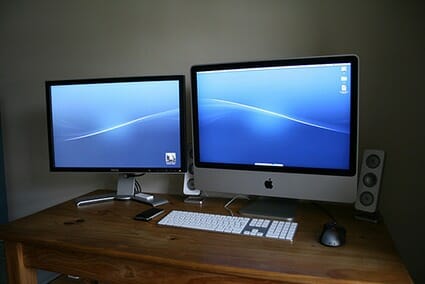Think You’re Working Too Much? Imagine How Your Eyes Feel!

Computers have become so common in the workplace, such that many Americans find themselves staring at a digital screen for upwards of six hours each day. It’s an inescapable necessity in this technology age — but while it may increase productivity, staring at a computer screen for work can also lead to adverse effects, by way of your vision and the health of your eyes.
The blanket term to describe those conditions linked to prolonged computer screen time is Computer Vision Syndrome, or CVS. Some of the associated ailments include dry eye, pain, blurred vision, headaches, and sensitivity to light. Computer Vision Syndrome in the workplace is a frequent grievance and if left unchecked, can turn into something quite serious.
There are ways to evade the ill effects of staring at a computer screen for work. Use the following tips to keep your eyes in shape and as healthy as possible.
Staring at a Computer Screen for Work – Blink More Often
Tears provide necessary lubrication for the eyes, as well as remove potentially harmful debris, such as dirt and air particulates. Those who continuously stare at a computer screen for work tend to blink less often, which in turn increases the evaporation of tears, causing dry eye and reducing the level of a vital protective protein, called mucin 5AC.
Make a conscious effort to blink more often, and you can reduce the potential for dry eye syndrome. By blinking, you refresh the eyes with a new layer of tears, thus minimizing dryness and irritation. Moderate use of eye drops can also provide relief.
Your Eyes and the Computer Screen at Work – Distance, Glare and Brightness
By comparison, people tend to stare much more closely at the computer screen than they would the printed page. Continuous close focus requires greater effort and puts a lot of stress on the eyes. Additionally, natural focal changes that occur in those over the age of 40—referred to as age-related presbyopia—make it even more difficult to narrow in on close objects. Pushing the computer screen back even a few inches can help reduce strain.
Adjusting the brightness of your computer screen and the lighting of the space in which you work can also be helpful. Excessively bright light, whether natural or artificial, can strain the eyes. Generally, your computer screen should be set to a comfortable level — nothing too vivid. Draw the drapes and dim overhead lighting, particularly fluorescent lights, to minimize glare.
Give Your Eyes a Break From the Computer Screen
Reduce strain and give your eyes a rest with the 20-20-20 rule. While at work, take regular breaks from the computer screen every 20 minutes and focus on something 20 feet away for 20 seconds.
Take Care of Your Eyes With Regular Eye Exams
Before starting any new job that requires a significant amount of screen time, schedule a visit with your eye care specialist to establish a baseline for your vision and eye health. Your doctor can instruct you on additional methods for preventing Computer Vision Syndrome.
Since CVS-related complaints are as common as computers in the workplace, the use of computer-specific eyewear has become more widespread. Ask your doctor whether computer glasses are a proper alternative. Be sure to schedule follow-up appointments each year to maintain the health of your eyes.
[Photo Via: William Hook]

